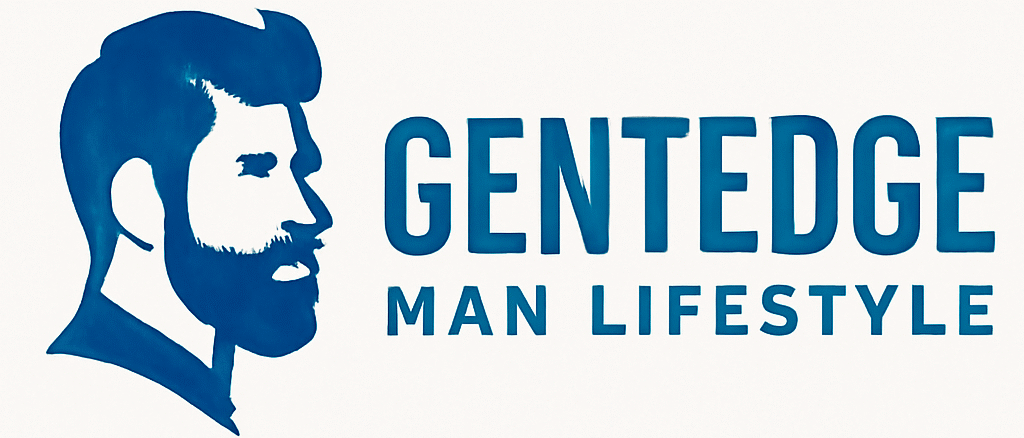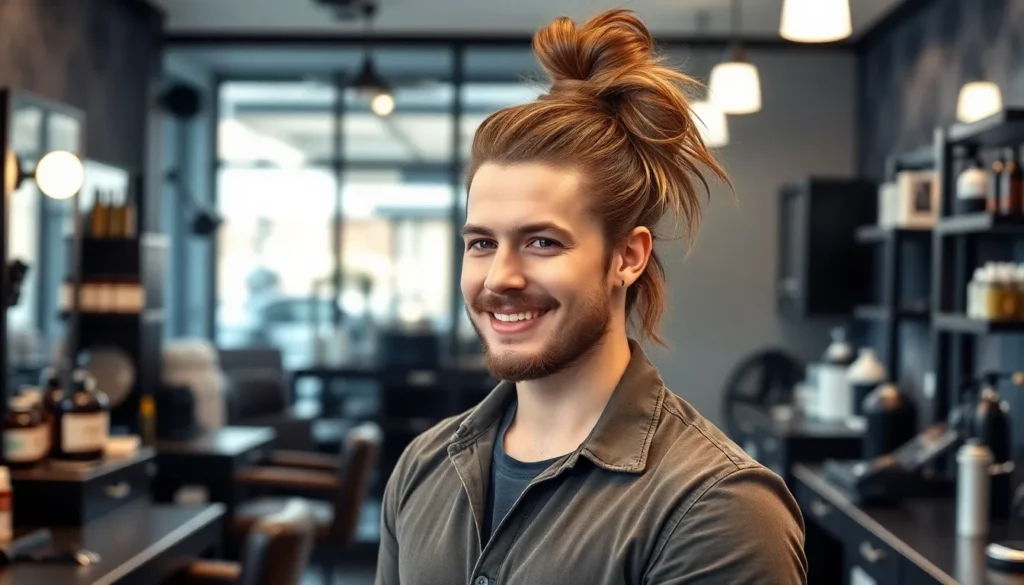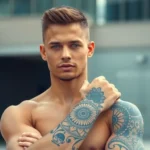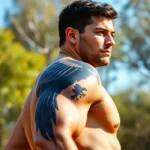Long hair doesn’t mean you’re stuck with just one look. We’ve discovered that men with longer locks actually have more styling options than their short-haired counterparts – you just need to know how to work with what you’ve got.
Whether you’re growing out your hair for the first time or you’re a seasoned long-hair veteran looking for fresh inspiration, the right cut can transform your entire appearance. From subtle layers that add movement to bold undercuts that create striking contrast, there’s a perfect style waiting for every face shape and lifestyle.
We’ll walk you through the most flattering haircuts for men with long hair that’ll have you looking sharp and feeling confident. These aren’t just trendy styles – they’re versatile cuts that work for everything from boardroom meetings to weekend adventures.
The Man Bun: A Versatile Classic for Long-Haired Men
We consider the man bun one of the most adaptable and timeless styles for men with long hair. This hairstyle seamlessly transitions from casual weekend looks to polished professional appearances with simple adjustments.
High Man Bun Style
Positioning your man bun at the crown creates an elevated, modern appearance that works exceptionally well for formal occasions. We recommend gathering your hair 3-4 inches above your ears to achieve the perfect high placement. Securing the bun with a clear elastic band maintains a clean finish while keeping flyaways under control.
Professional settings benefit greatly from this structured approach since the high position conveys confidence and attention to detail. We’ve found that adding a small amount of pomade before tying helps create a sleeker finish. Volume at the crown naturally elongates your face shape, making this variation particularly flattering for men with rounder facial features.
Low Man Bun Variation
Relaxed styling comes naturally with the low man bun positioned at the nape of your neck for an effortlessly cool vibe. We position this style just above the hairline where your neck meets your skull for optimal comfort during long wear periods. Casual environments like coffee shops, creative workspaces, and weekend activities suit this laid back approach perfectly.
Texture plays a crucial role in achieving the ideal low bun since slightly tousled hair creates more visual interest than overly groomed locks. We suggest scrunching your hair with sea salt spray before gathering to enhance natural waves and movement. Versatility shines through as you can easily loosen or tighten the bun throughout the day based on your activities.
Messy Bun Approach
Effortless styling defines the messy bun technique that embraces natural texture and deliberate imperfection for maximum appeal. We achieve this look by loosely gathering hair without brushing or combing first, allowing natural kinks and waves to create organic volume. Strategic pieces should be left to frame your face while others peek out from the bun itself.
Artistic professions and creative industries particularly appreciate this authentically disheveled aesthetic that suggests both talent and approachability. We recommend using dry shampoo to add grip and texture before styling, which helps maintain the deliberately undone appearance throughout the day. Movement becomes the key element as you want your messy bun to look like it naturally formed rather than being carefully constructed.
The Long Layered Cut: Adding Movement and Texture
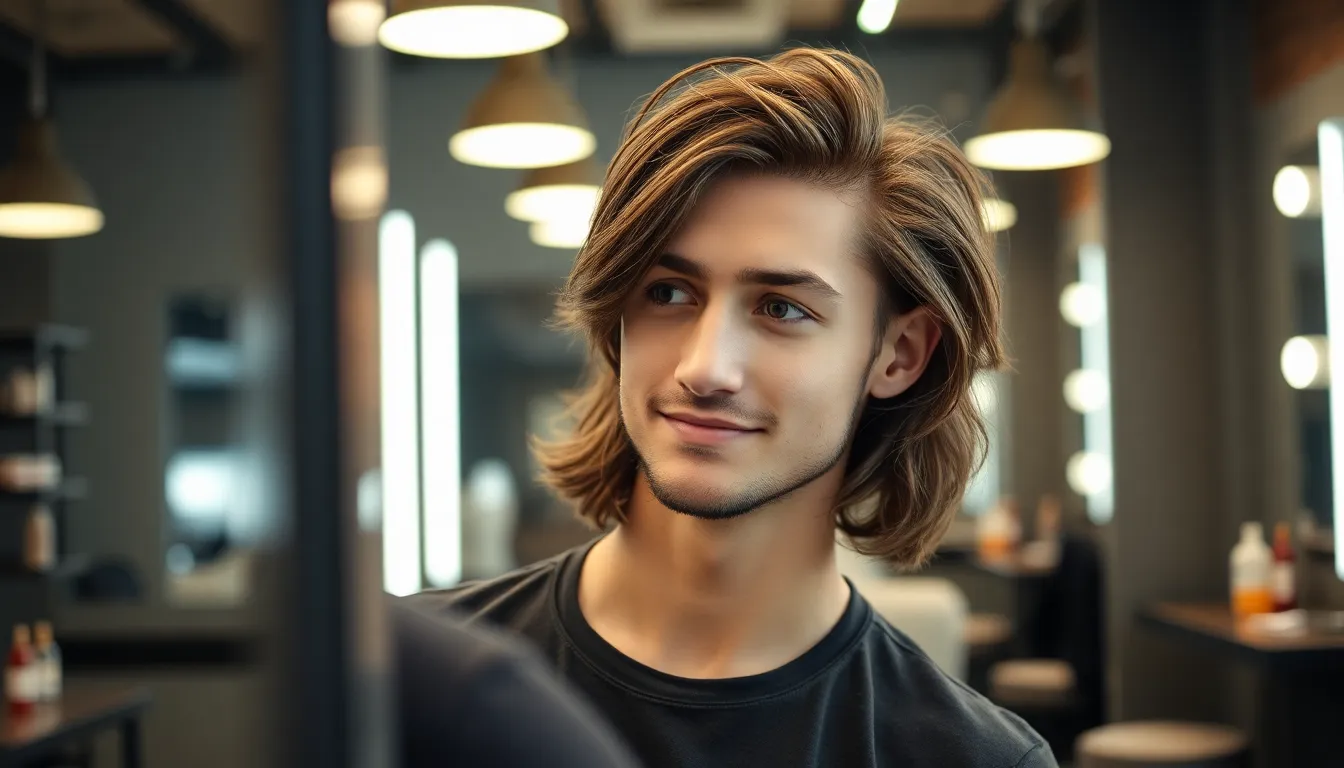
Layered cuts transform long hair by creating dimension and preventing that flat, heavy appearance that many men struggle with. We’ll explore three key layering techniques that can enhance your long hair’s natural movement and texture.
Face-Framing Layers
Face-framing layers strategically contour your features by cutting shorter lengths around the face that gradually blend into longer hair. These layers draw attention to your jawline and cheekbones while softening harsh angles for a more balanced appearance. Men with oval or round face shapes benefit most from this technique, as the strategic placement creates the illusion of more defined facial structure.
Creating these layers involves cutting the hair at precise angles that complement your bone structure. Your stylist will assess your face shape to determine the optimal length and placement for maximum impact. The result enhances your natural features while maintaining the overall length you’ve worked to achieve.
Graduated Length Layers
Graduated layers increase progressively in length from the crown to the ends, creating volume without sacrificing your hair’s overall length. This technique works exceptionally well for men with medium to thick hair who want to reduce bulk while maintaining their long style. Each layer builds upon the previous one, creating a cascading effect that adds dimension and movement.
Building volume through graduated layers prevents your hair from appearing weighed down or lifeless. The varying lengths create natural lift at the roots while allowing the ends to flow freely. This approach gives you the best of both worlds: maintaining length while achieving better shape and manageability.
Textured Layer Styling
Textured layers use different cutting angles to create a lived-in, effortless appearance that moves naturally throughout the day. Styling these layers with lightweight products like sea salt spray or mousse enhances the natural texture without weighing down your hair. This versatile approach adapts seamlessly between formal professional settings and casual weekend activities.
Improving texture through strategic layering works beautifully with wavy and curly hair types, allowing your natural patterns to shine. The varied lengths create movement that flows naturally, giving you that coveted effortless look that appears styled without being overly polished. Products should be applied sparingly to maintain the natural, flowing appearance that makes this cut so appealing.
The Shoulder-Length Shag: Effortless Rock Star Appeal
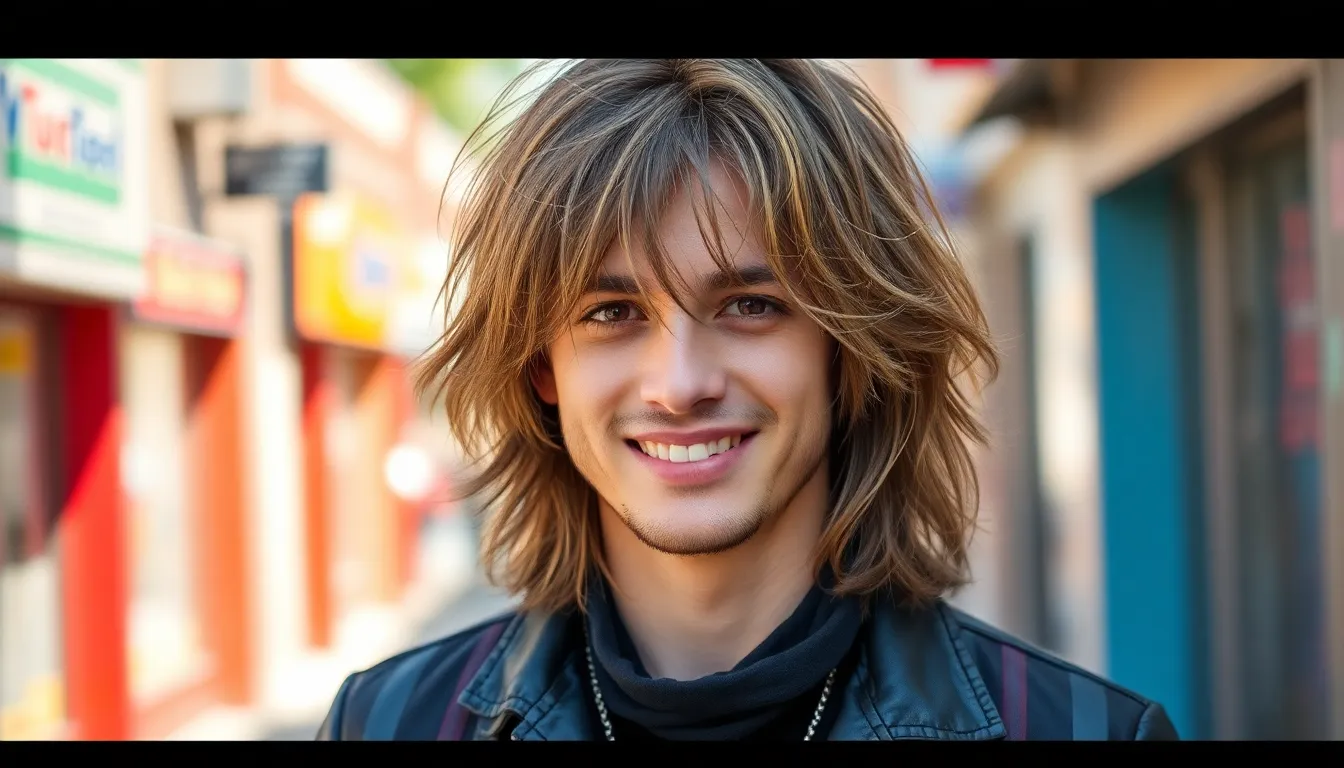
The shoulder-length shag brings that iconic rock star aesthetic to your everyday look with its naturally textured, carefree appearance. This versatile haircut features strategic layers and built-in volume that creates movement and dimension perfect for men wanting a laid-back yet stylish vibe.
Modern Shag Techniques
Choppy layers form the foundation of today’s shag haircuts, improving volume and movement throughout your hair. Stylists cut these layers at varying lengths to create that signature textured finish that looks effortlessly cool.
Layering techniques involve different cutting methods that add dimension and prevent your hair from looking flat or heavy. Professional barbers use point cutting and razor techniques to achieve that lived-in texture that makes the shag so appealing.
Textured finishes complete the modern shag look by creating natural-looking movement and separation between layers. We recommend using lightweight products like mousse or sea salt spray to enhance this windblown appearance without weighing down your hair.
Styling Tips for Volume
Blow drying with a round brush creates the volume that makes shoulder-length shags truly shine. Lift your hair at the roots while directing heat upward to maximize that rock star fullness we’re after.
Lightweight products work best for maintaining the shag’s natural texture without creating heaviness. Apply mousse or sea salt spray to damp hair before styling to achieve that perfect balance of hold and movement.
Air drying offers an alternative approach that emphasizes the shag’s natural texture and creates a more relaxed finish. This method works especially well when you want that effortless, just-rolled-out-of-bed rock star appeal.
Maintenance Requirements
Regular trims every 6-8 weeks keep your shag looking fresh and prevent split ends from compromising the style’s textured appearance. Consistent maintenance ensures those choppy layers maintain their shape and movement.
Conditioning treatments become essential for managing longer hair and preventing the frizz that can make your shag look unkempt. We suggest using deep conditioning masks weekly to keep your hair healthy and manageable.
Heat protection should never be skipped when styling your shag with blow dryers or other heat tools. Always apply a heat protectant spray to prevent damage that could affect your hair’s natural texture and overall health.
The Long Bob (Lob): Contemporary and Professional
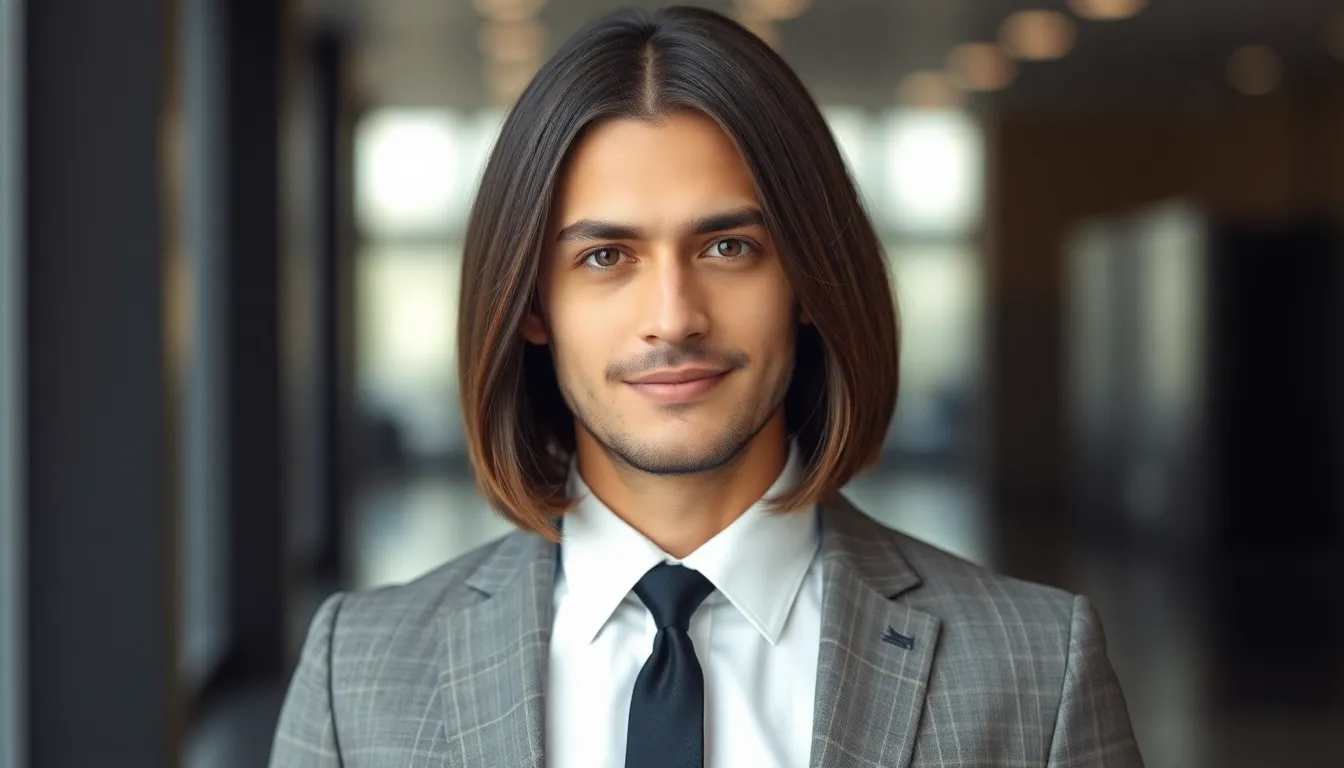
The long bob brings modern sophistication to men’s long hairstyles, offering a polished look that transitions seamlessly from office to evening events. We’ve seen this versatile cut gain popularity among professionals who want to maintain longer hair while projecting a refined image.
Straight Lob Styling
Straight lob styling creates a sleek, minimalist appearance that works perfectly in corporate environments. We recommend keeping the length between the shoulders and collarbone for optimal professionalism. The key lies in achieving smooth, straight lines that frame the face without appearing overly feminine.
Use a flat iron with ceramic plates to create the signature sleek finish. Temperature settings between 300-350°F work best for most hair types. Apply a heat protectant spray before styling to prevent damage and maintain the hair’s natural shine.
Regular trims every 6-8 weeks maintain the lob’s sharp edges and prevent split ends. We suggest asking your barber for subtle graduation in the back to avoid the haircut looking too blunt or heavy.
Wavy Lob Variations
Wavy lob variations add texture and movement while maintaining the style’s professional appeal. Natural waves work beautifully with this cut, creating an effortless yet polished appearance. The waves soften the geometric lines of the traditional lob while adding visual interest.
Create loose waves using a 1.5-inch curling iron or sea salt spray for natural texture. We prefer the scrunch method with damp hair and texturizing products for a more organic wave pattern. This technique produces subtle waves that look naturally occurring rather than overly styled.
Beach wave techniques work particularly well for casual Friday or creative workplace environments. Apply mousse to towel-dried hair and scrunch gently while air drying. This method creates effortless waves that complement the lob’s contemporary aesthetic.
Asymmetrical Lob Options
Asymmetrical lob options provide an edgier take on the classic cut while remaining workplace appropriate. One side typically measures 1-2 inches longer than the other, creating visual interest without appearing too avant-garde. This variation works especially well for men with strong jawlines or angular face shapes.
The subtle angle difference creates movement and prevents the style from looking too uniform. We recommend starting with a minimal length difference and gradually increasing it in subsequent cuts if desired. This approach allows you to test the asymmetrical look without committing to a dramatic change.
Style asymmetrical lobs by emphasizing the longer side with strategic parting and product placement. Use a lightweight styling cream on the longer section to enhance its prominence. The shorter side can be tucked behind the ear or styled forward to create additional contrast between the two lengths.
The Ponytail Cut: Sleek and Sophisticated
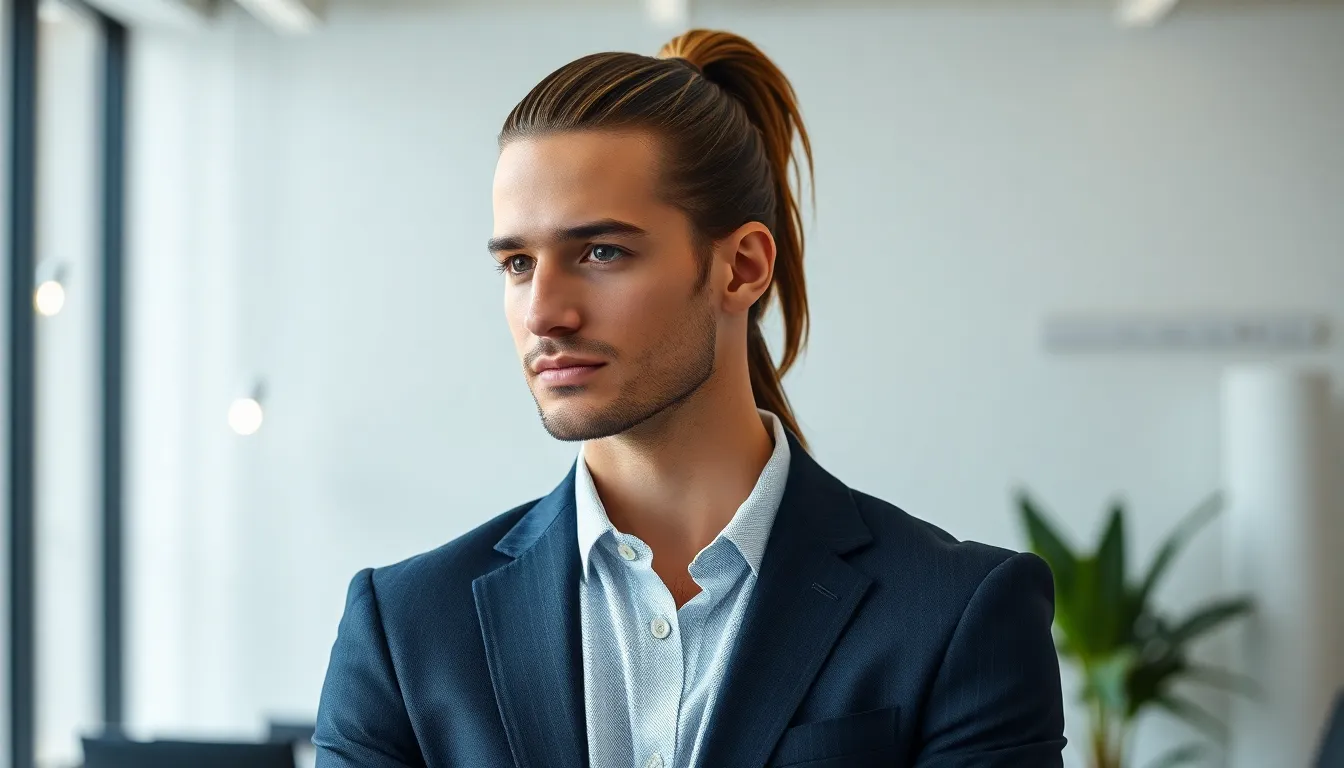
We’ve explored various styles for long hair, and now we’re highlighting the ponytail cut for its perfect blend of practicality and sophistication. This classic approach works beautifully for men seeking a polished appearance that transitions effortlessly from professional to casual settings.
High Ponytail Setup
Positioning your ponytail at or above the crown creates an elevated, ever-changing look that’s particularly striking on men with thick hair. We recommend securing the hair tightly to prevent loose strands from compromising the clean aesthetic. This style keeps hair completely out of your face while adding a modern edge that works well in active environments.
Specialized hair ties designed for men’s hair provide superior hold without causing breakage or slipping. We suggest using elastic bands that match your hair color for a seamless appearance. Professional styling products like pomade or gel help smooth any flyaways and enhance the overall visual appeal of this elevated style.
Thick hair textures benefit most from the high ponytail configuration because the volume creates natural lift and presence. We find that men with dense, coarse hair achieve the most dramatic results with this positioning. The height draws attention upward and creates an assertive, confident silhouette that’s perfect for business presentations or formal events.
Low Ponytail Elegance
Securing your ponytail at the nape of your neck delivers a relaxed, refined appearance that adapts to virtually any situation. We appreciate how this positioning creates a sophisticated backdrop that doesn’t compete with facial features. The low placement works exceptionally well for men with layered cuts or natural texture variations.
Versatility defines the low ponytail’s greatest strength, as it transitions seamlessly between casual coffee meetings and black tie events. We’ve observed that this style flatters most face shapes while maintaining a professional demeanor. The understated elegance makes it an ideal choice for men who prefer subtle sophistication over bold statements.
Textured hair types particularly shine with low ponytail styling because the natural movement enhances the overall effect. We recommend leaving a few face framing pieces loose for added softness when appropriate. This approach prevents the style from appearing too severe while maintaining the clean, collected appearance that makes ponytails so appealing.
Braided Ponytail Combinations
Integrating braids into your ponytail design introduces texture and creative flair that elevates the basic style significantly. We love how small accent braids along the temples or crown area add visual interest without overwhelming the overall look. These subtle details work perfectly for men who want to express individuality while maintaining professionalism.
Half up braided sections create a striking contrast when combined with a traditional ponytail base. We suggest starting with a small Dutch or French braid at the hairline and incorporating it into the ponytail gathering point. This technique works beautifully for both everyday wear and special occasions, offering a unique twist on the classic style.
Full braided ponytails make bold statements that suit men comfortable with expressive styling choices. We recommend this approach for creative professionals or those attending festivals and artistic events. The technique involves braiding the entire length after securing the initial ponytail, creating a rope like texture that’s both practical and visually striking.
Color accents and extensions can enhance braided ponytail combinations for men seeking maximum impact. We’ve seen excellent results with subtle highlights woven through the braids or temporary color additions for special events. These customizations allow for personal expression while maintaining the foundational elegance of the ponytail structure.
The Half-Up Style: Balancing Length and Control
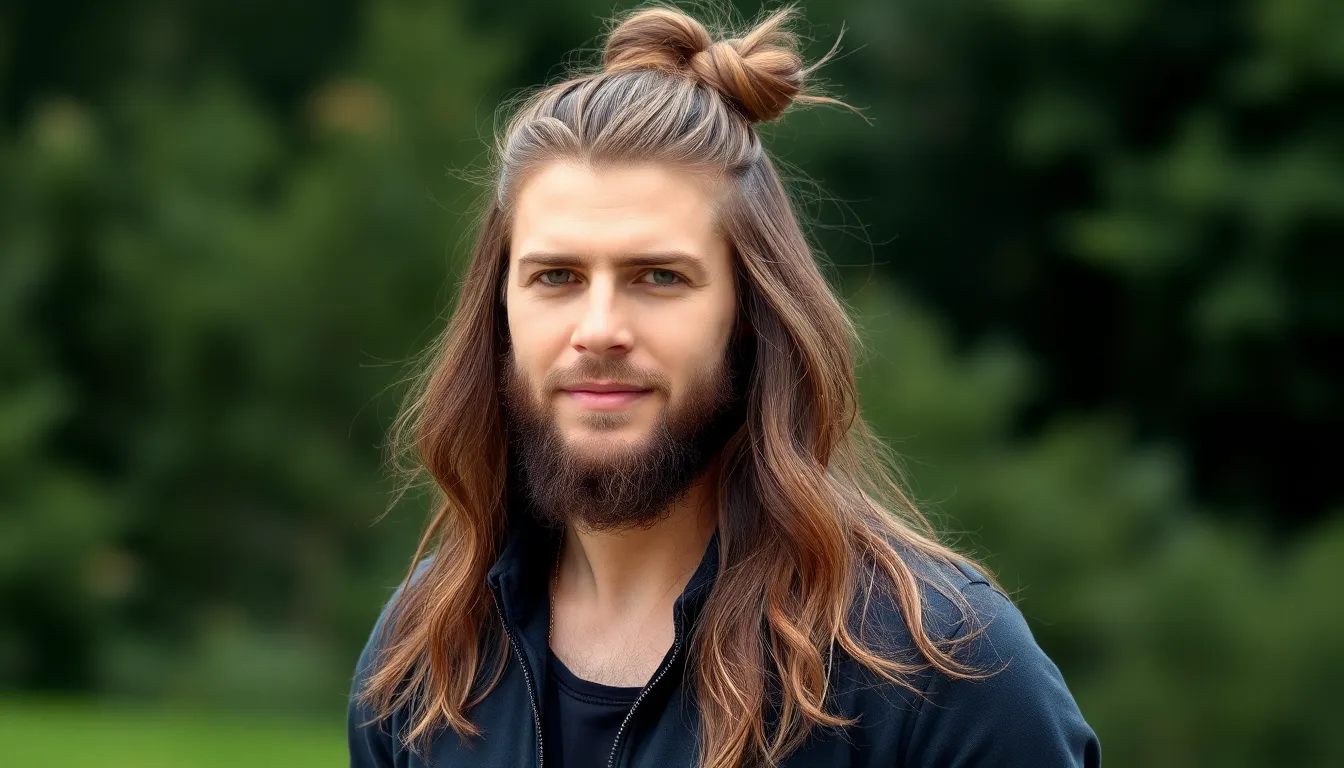
The half-up style offers long-haired men the perfect compromise between showcasing length and maintaining practical control. This versatile approach keeps hair off the face while preserving the aesthetic appeal of flowing locks.
Top Knot Half-Up
Top knot half-up styles create an instant focal point by gathering the upper portion of hair into a compact bun at the crown. We recommend this technique for men wanting to maintain their long hair’s visual impact while achieving a tidy, controlled appearance. The positioning at the crown naturally draws attention upward, making it particularly flattering for most face shapes.
Creating this look requires gathering only the top half of your hair, leaving the bottom section to flow freely. The small bun formation works exceptionally well for straight, wavy, or curly textures, adapting to your hair’s natural characteristics. Daily maintenance becomes effortless since you can quickly tie up the front sections when needed while keeping the overall length intact.
Braided Half-Up Variations
Braided half-up variations introduce texture and visual complexity that transforms a simple style into something more distinctive. We’ve observed that single central braids create a clean, symmetrical look that works well in professional settings. Double braids positioned on each side offer a more casual, relaxed vibe that’s perfect for weekend activities.
Cornrow-style patterns provide the most dramatic transformation, creating geometric designs that enhance the rugged aesthetic many long-haired men prefer. These braided techniques work particularly well with textured or wavy hair, as the natural movement complements the braiding pattern. The combination of braids with loose hair creates an appealing contrast between structured and free-flowing elements.
Twisted Half-Up Techniques
Twisted half-up techniques add sophistication through gentle manipulation of hair sections before securing them back. We find that twisting creates a softer, more romantic aesthetic compared to the sharper lines of braids or the compact nature of buns. This method works beautifully when combined with other techniques or used independently for a subtle styling approach.
The twisting process helps define your hair’s natural texture while creating visual interest through the spiral patterns. Formal occasions benefit from the refined appearance of twisted sections, while casual settings appreciate the effortless, lived-in quality this technique provides. Hair naturally gains dimension and movement through the twisting process, making it an excellent choice for adding volume to finer hair types.
The Curtain Bangs with Long Hair: Retro Meets Modern
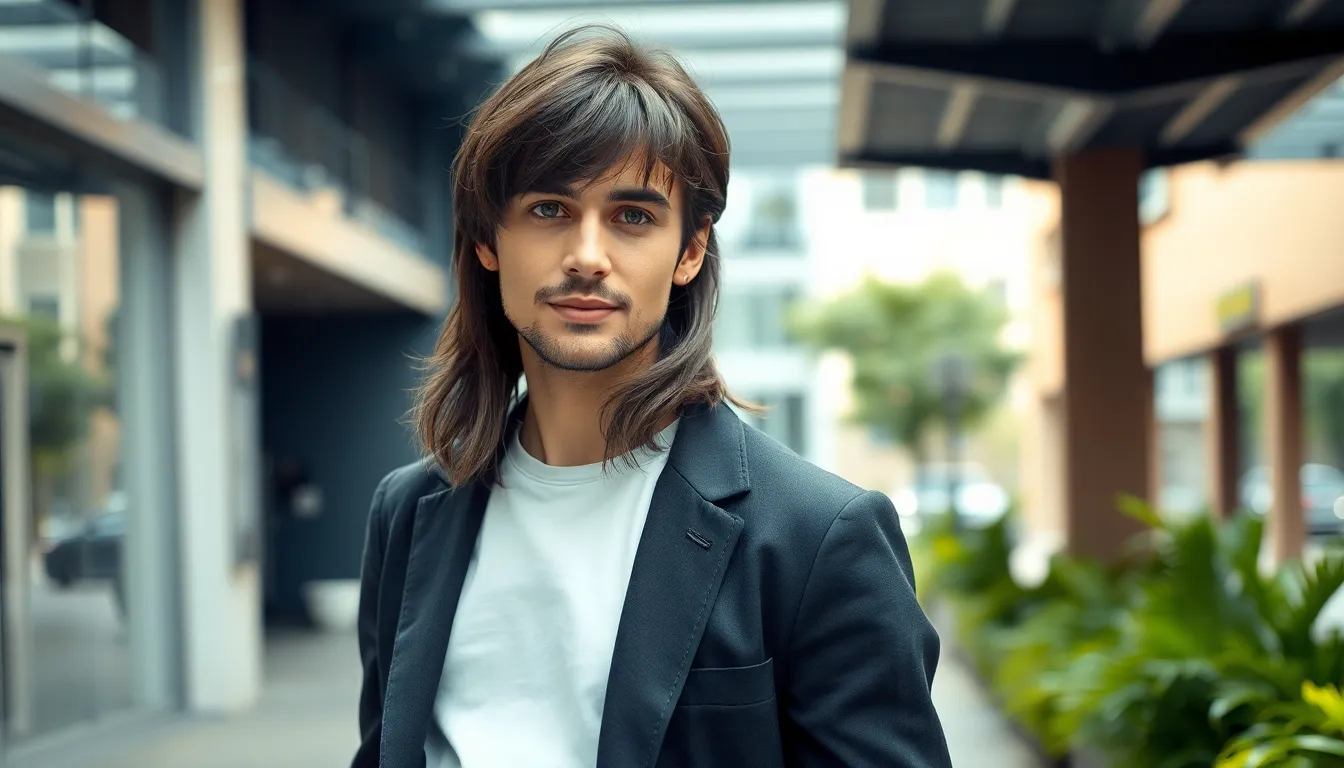
Curtain bangs offer long-haired men the perfect balance between vintage charm and contemporary style. This versatile fringe technique frames the face beautifully while maintaining the flowing elegance of longer locks.
Center-Parted Curtain Bangs
Center-parted curtain bangs create a symmetrical frame that enhances facial features through strategic hair placement. We see this style work exceptionally well for men with oval or heart-shaped faces, as the middle part draws attention to the eyes while softening angular jawlines. The key lies in cutting the bangs to fall naturally around the temples, typically reaching mid-cheek length for optimal face framing.
Creating this look requires precise sectioning techniques that follow the natural growth patterns of your hair. Your stylist should start with damp hair, creating a triangle section from the center of your forehead that extends back about two inches. The cutting angle should slope downward from the center part, ensuring both sides mirror each other perfectly.
Styling becomes effortless once you master the blow-drying technique that enhances the natural fall of the bangs. We recommend using a round brush to direct hair away from the center part while applying gentle heat from above. This method creates the characteristic curtain effect that separates naturally at the middle.
Side-Swept Curtain Options
Side-swept curtain bangs provide an asymmetrical approach that adds modern sophistication to traditional long hairstyles. This variation works particularly well for men with square or rectangular face shapes, as the diagonal line softens harsh angles while creating visual interest. The sweep direction should complement your natural hair growth pattern and preferred styling routine.
Achieving the perfect side sweep involves cutting the bangs at a graduated angle that’s longer on one side. We suggest starting with the shorter side at eyebrow length, gradually increasing to cheekbone length on the swept side. This creates a natural flow that blends seamlessly with the rest of your long hair.
The beauty of side-swept curtains lies in their adaptability to different styling preferences and occasions. Professional settings benefit from a more controlled sweep achieved with lightweight pomade, while casual environments allow for a more relaxed, tousled appearance using sea salt spray.
Styling and Maintenance Tips
Daily styling of curtain bangs requires minimal effort when you understand the fundamental techniques that work with your hair’s natural texture. We recommend starting with slightly damp hair and using a light hold hairspray to maintain the shape throughout the day. The key is applying product sparingly to avoid weighing down the delicate fringe area.
Regular maintenance becomes crucial for preserving the curtain bang silhouette and preventing overgrowth that disrupts the style. Schedule trims every 4-6 weeks to maintain the proper length and prevent split ends that can compromise the smooth curtain effect. Between salon visits, we suggest using sharp styling scissors to carefully trim any pieces that grow past the desired length.
Heat protection proves essential when styling curtain bangs, as the face-framing sections receive frequent attention during your daily routine. Apply a thermal protectant spray before using any heated tools, and limit high-temperature styling to prevent damage that could affect the bang’s natural movement and shine.
The Beach Wave Cut: Relaxed Surfer Vibes
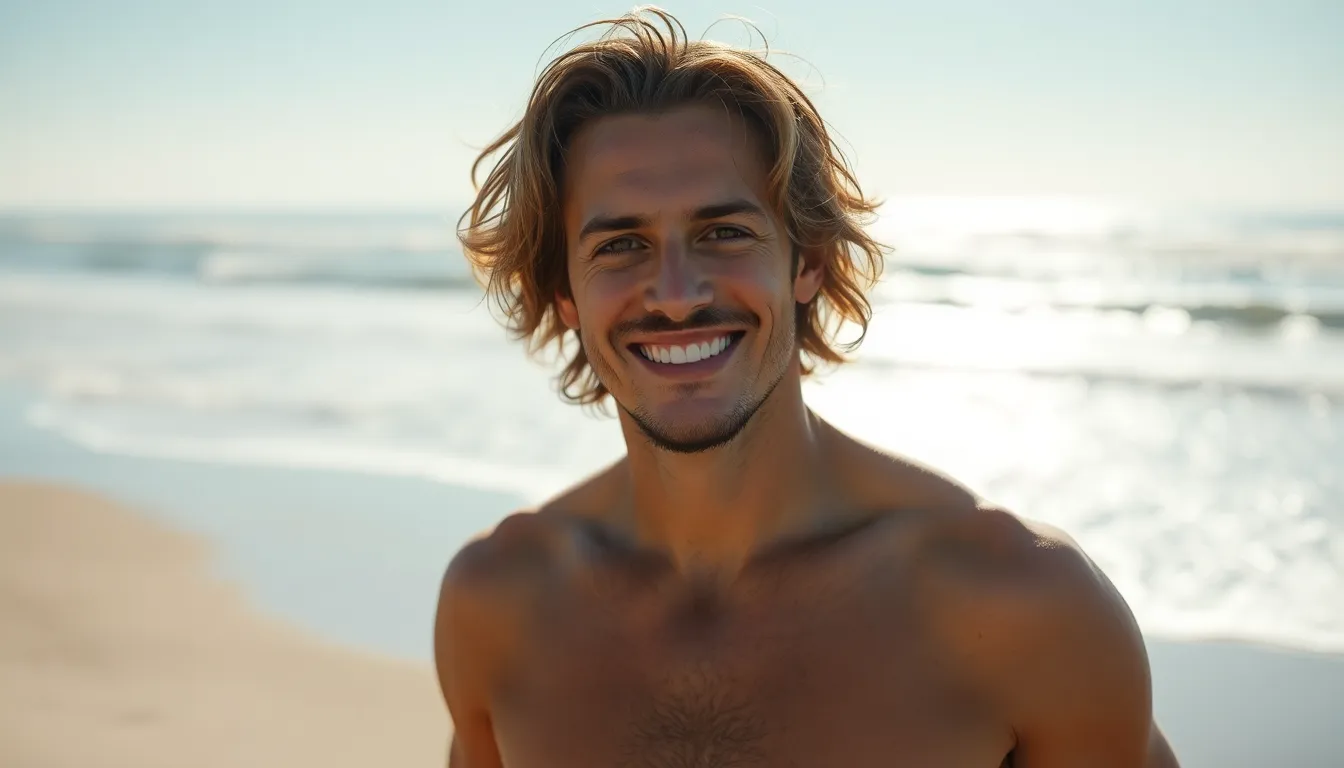
The Beach Wave Cut brings effortless surfer aesthetics to men’s long hair, creating a relaxed yet stylish appearance that’s perfect for casual settings. This popular hairstyle maintains shoulder length or longer hair while embracing natural texture and movement.
Natural Wave Enhancement
Natural waves become the foundation of this laid back style for men blessed with wavy or curly hair textures. Men with straighter hair can achieve similar results using wave improving products that work with their natural hair patterns. Length around the shoulders or below allows waves to fall naturally and frame facial features beautifully.
Face shapes benefit from this versatile cut, especially when paired with a middle or off center part that complements your bone structure. Hair naturally develops more texture and body when left to grow longer, making this style ideal for those transitioning from shorter cuts. Regular trims prevent split ends while maintaining the healthy appearance that makes beach waves look authentic.
Salt Spray Techniques
Salt spray creates the signature texture that defines beach wave styling for long haired men. Mist the product onto damp or dry hair, concentrating on mid lengths and ends where natural movement occurs. Sea water effects get simulated through these specialized formulas that enhance existing waves while reducing oiliness.
Definition and body increase dramatically when salt spray is applied correctly to achieve that coveted matte finish. Focus your application technique on avoiding the roots to prevent weighing down your hair’s natural volume. Tousled textures emerge as the product works to create that effortless, just left the beach appearance that characterizes this popular men’s hairstyle.
Scrunching Methods
Scrunching techniques amplify beach waves by encouraging natural curl patterns to form throughout your long hair. Gather sections of damp hair in both hands and gently squeeze upward from ends toward your scalp after applying texturizing products. Wave formation and volume increase significantly through this simple yet effective styling method.
Damp hair responds best to scrunching motions that create lasting texture without causing frizz or damage. Air drying preserves wave integrity better than heat styling, though you can use a diffuser on low heat settings if time is limited. Gentle squeezing motions should be repeated throughout your hair to ensure even wave distribution and maximum volume creation.
The Straight and Sleek: Minimalist Elegance
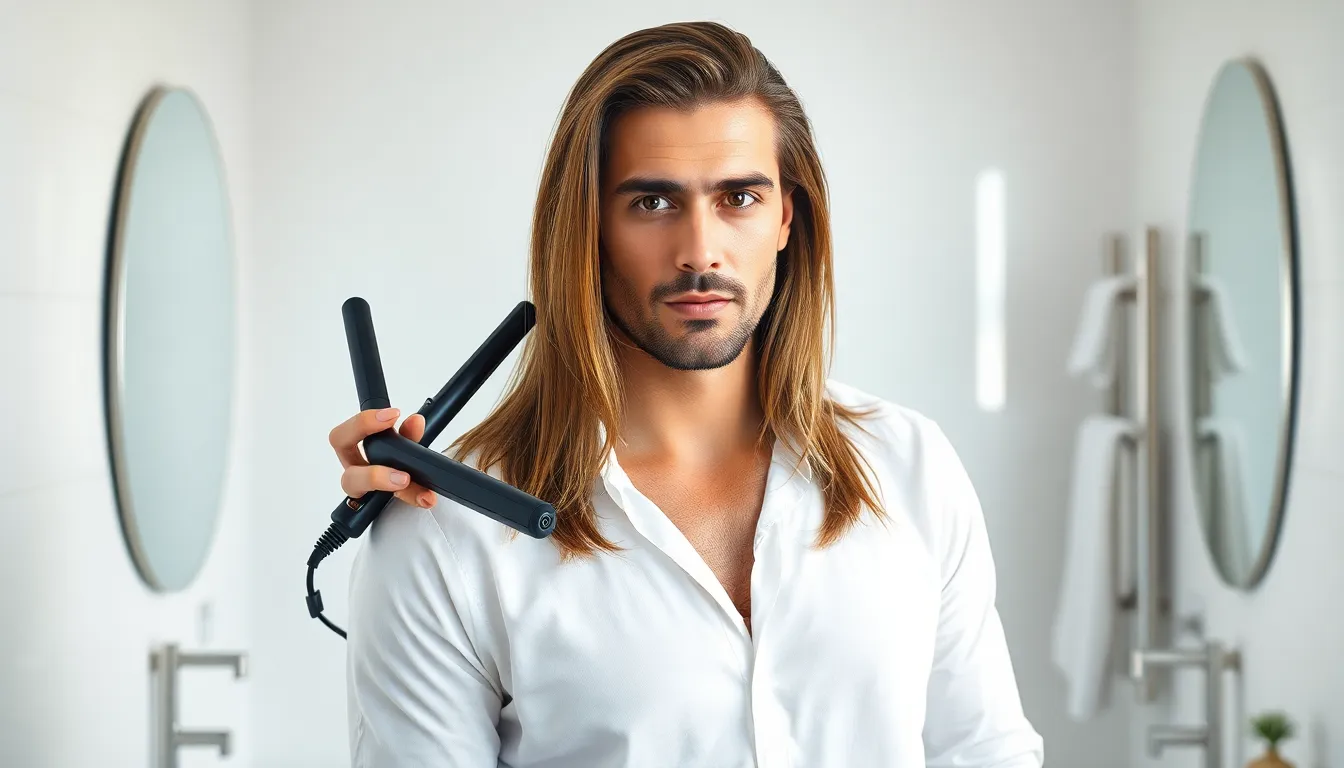
This classic straight hairstyle offers men with long hair a sophisticated, polished appearance that works seamlessly across professional and casual settings. The versatility of this minimalist approach makes it one of the most popular choices for those seeking an elegant yet low-maintenance look.
Heat Styling Approaches
Straightening techniques form the foundation of achieving this sleek aesthetic. We recommend using a flat iron on slightly damp hair, working in small sections from roots to ends for maximum smoothness. Temperature control becomes crucial here—keep your flat iron between 300-350°F to prevent unnecessary heat damage while still achieving professional results.
Smoothing methods with a blow dryer create the perfect base for straight styles. Start by applying a heat protectant spray throughout your hair, then use a paddle brush while blow drying in a downward motion. This technique seals the hair cuticle and creates that mirror-like shine characteristic of the straight and sleek look.
Sectioning strategies ensure even heat distribution and consistent results. Divide your hair into horizontal layers, starting from the bottom and working upward. Each section should be no thicker than half an inch to guarantee thorough straightening without repeated passes that can cause damage.
Product Recommendations
Heat protectant spray serves as your first line of defense against styling damage. Apply this essential product from mid-length to ends before any heat styling, creating a protective barrier that prevents frizz and maintains hair health. Quality heat protectants can reduce heat damage by up to 50% when used consistently.
Smoothing serums provide the finishing touch for ultra-sleek results. Look for silicone-based formulas that create a protective coating while adding incredible shine. A dime-sized amount distributed through damp hair before styling will eliminate flyaways and lock in smoothness for hours.
Anti-humidity products become essential for maintaining your straight style throughout the day. These specialized formulas create a moisture barrier that prevents environmental humidity from disrupting your sleek look, especially important in humid climates or during seasonal weather changes.
Daily Maintenance Routine
Brushing techniques require gentle, methodical approaches to prevent breakage in straightened hair. Use a wide-tooth comb on wet hair immediately after washing, then switch to a natural bristle brush once hair is completely dry. Always brush from ends upward to minimize tension on the hair shaft.
Styling consistency maintains the integrity of your straight look with minimal daily effort. Sleep on silk or satin pillowcases to reduce friction, and consider loose braiding before bed to prevent tangling. Morning touch-ups typically require only a quick pass with your flat iron on problem areas.
Washing schedules should be adjusted to preserve your straight style longer. Most men can extend their straight look for 2-3 days with proper nighttime care and dry shampoo applications. When you do wash, use sulfate-free shampoos that won’t strip natural oils essential for maintaining healthy, sleek hair.
The Braided Styles: Creative and Functional Options

Braided styles combine functionality with creativity, making them perfect for men who want to manage their long hair while expressing personal style. These versatile techniques offer everything from simple daily answers to intricate artistic expressions.
Single Braid Variations
Classic three-strand plaits represent the most straightforward approach to braided styling for long-haired men. We can position these single braids at the crown, along the side, or at the nape for different aesthetic effects. The classic plait secures hair away from the face while adding a distinctive, masculine touch to your overall appearance.
Half-up, half-down braids offer exceptional versatility for men seeking a balance between control and flow. This technique involves braiding only the upper portion of your hair while leaving the rest loose and natural. We find this style particularly effective when integrated with a man bun or left completely loose for a more relaxed vibe.
Single side braids create an asymmetrical look that’s both practical and stylish. Positioning the braid along one side of your head adds visual interest while keeping hair manageable during daily activities. These braids work exceptionally well for athletic settings or when you need to maintain a professional appearance while showcasing your longer locks.
Multiple Braid Techniques
Cornrows involve creating tight braids close to the scalp in distinctive patterns like boxes or zigzag designs. We recommend this technique for men who want a bold, structured look that keeps hair completely controlled. Cornrows provide excellent function for athletic activities while maintaining a striking visual impact that works in both casual and formal settings.
Stitch braids feature visible parted lines between each braid, creating a more intricate pattern than traditional cornrows. This technique allows for greater creativity in design while providing the same practical benefits of keeping hair secure and manageable. We often see stitch braids paired with geometric patterns for a modern, artistic appearance.
Double or triple braids can be styled symmetrically or asymmetrically depending on your preference and face shape. These multiple braid arrangements work particularly well when paired with a man bun for a neat, controlled finish. We find that this technique suits both daily wear and special occasions, adapting seamlessly between professional and casual environments.
Decorative Braiding Elements
Bead and ring accessories transform simple braids into personalized artistic statements using metal, plastic, or wooden elements. We can incorporate these decorative pieces throughout single or multiple braids to enhance individuality and emphasize exact hairstyle details. These accessories work particularly well for men who want to express their personal style while maintaining the practical benefits of braided hair.
Colored extensions add vibrant accents to braided styles without requiring permanent hair color changes. Incorporating temporary color elements allows you to experiment with different looks while keeping your natural hair intact. We recommend using high-quality synthetic or human hair extensions that blend seamlessly with your natural texture and color.
Undercut patterns create striking contrasts between braided sections and shaved areas of the scalp. This combination technique involves incorporating geometric or artistic shaved designs that complement the braided portions of your hairstyle. We find that undercut patterns work exceptionally well for men who want to emphasize the texture and length of their braided hair while adding contemporary edge to their overall appearance.
Conclusion
We’ve explored an extensive range of long hairstyles that prove men with lengthy locks have countless options for expressing their personal style. From professional man buns to relaxed beach waves each cut offers unique benefits that can complement different face shapes lifestyles and occasions.
The key to mastering any of these styles lies in understanding your hair’s natural texture and choosing cuts that work with rather than against it. Whether you prefer the structured elegance of a straight sleek look or the creative freedom of braided styles the right technique and products will help you achieve your desired aesthetic.
Remember that maintaining long hair requires dedication to proper care routines including regular trims quality products and protective styling practices. With the right approach your long hair can become your signature feature that sets you apart while keeping you looking polished and confident in any setting.
Frequently Asked Questions
What are the most versatile long hairstyles for men?
The man bun (high and low variations) and long layered cuts are among the most versatile options. Man buns work for both formal and casual settings, while layered cuts add movement and texture that adapts to different occasions. The ponytail cut also offers excellent versatility, transitioning seamlessly from professional to casual environments.
How do I choose the right long hairstyle for my face shape?
Face-framing layers work well for most face shapes by contouring features. Oval and heart-shaped faces suit center-parted curtain bangs, while side-swept bangs soften angular features. The key is selecting cuts that enhance your natural facial structure rather than working against it.
What’s the difference between a high man bun and low man bun?
A high man bun sits at the crown of your head, creating a polished, formal appearance ideal for professional settings. A low man bun is positioned at the nape of your neck, offering a more relaxed, casual vibe suitable for everyday wear and informal occasions.
How do I maintain long hair health while styling?
Regular trims every 6-8 weeks prevent split ends, while conditioning treatments keep hair moisturized. Always use heat protection products before styling, opt for lightweight products to avoid weighing hair down, and follow proper nighttime care routines with silk pillowcases or loose braids.
What products do I need for beach wave styling?
Essential products include sea salt spray for texture, wave-enhancing mousse for volume, and heat protectant if using styling tools. Scrunching products while hair is damp and allowing natural air drying helps achieve the effortless, relaxed beach wave look.
Can long hairstyles work in professional environments?
Absolutely. The long bob (lob), straight and sleek styles, and well-groomed ponytails are excellent professional options. The key is maintaining clean lines, regular trims, and polished styling that looks intentional rather than unkempt.
How often should I trim long hair?
Long hair should be trimmed every 6-8 weeks to maintain health and shape. However, specific styles like curtain bangs may need more frequent touch-ups every 4-6 weeks to maintain their frame and prevent them from growing into your eyes.
What’s the best way to style curtain bangs?
Start with damp hair and use a round brush while blow-drying, curling the bangs away from your face. Apply heat protectant first, then use a small amount of styling cream for hold. The key is creating that swooping motion that frames your face naturally.
Are braided styles appropriate for men?
Yes, braided styles are increasingly popular and accepted for men. Single braids, cornrows, and braided ponytails offer practical hair management while expressing personal style. They work particularly well in creative industries and casual settings, and can be enhanced with decorative elements.
How do I prevent long hair from looking flat?
Use lightweight volumizing products, avoid over-conditioning the roots, and incorporate layered cuts to add movement. Blow-drying with a round brush, using root-lifting sprays, and avoiding heavy oils near the scalp all help maintain volume and prevent that flat, lifeless appearance.
